US merger rush stirs debate over equities bull market
Some see signs of rally’s impending end in rash of multibillion dollar tie-ups
by Jennifer Ablan, Eric PlattIt is boom time once again in corporate America, as chief executives agree to a rush of multibillion-dollar tie ups. But the consolidation — which topped $70bn this week alone and included deals for the high end jeweller Tiffany and discount broker TD Ameritrade — has left investors with a burning question: is this a signal of the bull market’s impending end?
The rising proportion of stock-based M&A deals — the highest level since 2000 — is just one alarm bell of possible late-cycle behaviour.
Takeovers where an acquirer pays only with its own stock, as brokerage Charles Schwab did this week when it agreed to buy smaller rival TD Ameritrade for about $26bn, account for nearly 20 per cent of deals this year, according to data provider Refinitiv.
High valuations for the $3.4tn worth of takeovers agreed so far this year have also made US stock investors nervous.
Companies and buyout groups are paying about 22.5 times the net income a target generates in a year. While that is down from a 2018 peak, it remains at its second-highest level since 1998. This has affected how companies are deciding to structure their takeovers as well as whether they go ahead with a deal at all.

Winston Chua, an analyst at TrimTabs Investment Research, pointed out that flurries of M&A tend to peak around market tops as “companies attempt to buy growth rather than grow companies organically”.
In the past, record dealmaking has coincided with market peaks, as it did on the eve of the dotcom boom-and-bust in 1999 and 2000 and then again ahead of the financial crisis in 2006 and 2007.
Mark Grant, chief global strategist at investment bank B. Riley FBR, said that he thinks equities are “toppy”, given stretched valuations and slowing earnings momentum, adding: “The rash of M&A deals shows companies are looking for growth.”
Optimists believe this time is different. To them, supportive monetary policies from major central banks, including the Federal Reserve and the European Central Bank, can lengthen the ageing and vulnerable M&A and stock market cycle.
“A pick-up on M&A could fuel and lengthen any ongoing rally in the stock market,” said Jim Paulsen of the Leuthold Group. “It may eventually signal a market peak but it could be from much higher levels. M&A is just a single indicator among many impacting stock market conditions.”
Meanwhile, investors’ ferocious appetite for returns and yield, particularly against the backdrop of trillions of dollars of negative-yield bonds, has sent them looking for income and opportunities in equities.
“What we are seeing in the recent bump in M&A activity is that corporates and other investors have concluded that despite the advanced age of the current cycle we are not about to descend into a recession, rather that the current cycle still has legs,” said Eric Shube, head of US M&A at law firm Allen & Overy.
Hedge fund investor Thomas Hayes of investment firm Great Hill Capital believes dealmaking could yet accelerate without signalling a market top, particularly if a trade deal between the US and China is agreed and a global downturn is averted. One test case that investors can look to is 2015, when M&A set a record high. While that year was followed by a brief slowdown at the start of 2016 alongside a slide in commodity prices, dealmaking and stock prices ultimately recovered.
“The cycle has room to run and will be reflected in accelerating M&A,” he said. “It's a sign that animal spirits are coming back into the market and fear is thawing.”

But the rush of big-ticket M&A deals set against the old age of the current upswing in major equities markets still has many market watchers on edge. The risk of a near-term pullback for the benchmark S&P 500 index is “quite high” following its 25 per cent surge so far this year, said Lori Calvasina, head of US equity strategy at RBC Capital Markets.
“Levels of confidence have been trending lower and are well below the highs of the current cycle. The most noteworthy deterioration has occurred in the Conference Board CEO gauge, which is actually nearing levels typically seen in recessions,” she said.
Bankers who work on mergers said that the higher prices for companies, as well as fear that the stock market is due for a correction, has prompted boards to use their own stock for deals with the view that if stocks do decline, they will at least be saved from overpaying for a takeover with cash.

Investors have warned of other signs of a market top already this year, pointing to overhyped valuations of venture capital-backed groups like property leasing company WeWork — the SoftBank-backed group that ultimately had to restructure itself.
News that private equity giant KKR had submitted a bid for the $70bn drugstore chain Walgreens Boots Alliance, which would amount to the largest leveraged buyout in history if agreed, also reverberated across Wall Street, with some investors pointing back to the last big PE boom ahead of the financial crisis. Days earlier, rating agency Fitch warned that losses on leveraged loans, a market that is critical in funding buyouts, would experience greater losses than it previously thought.